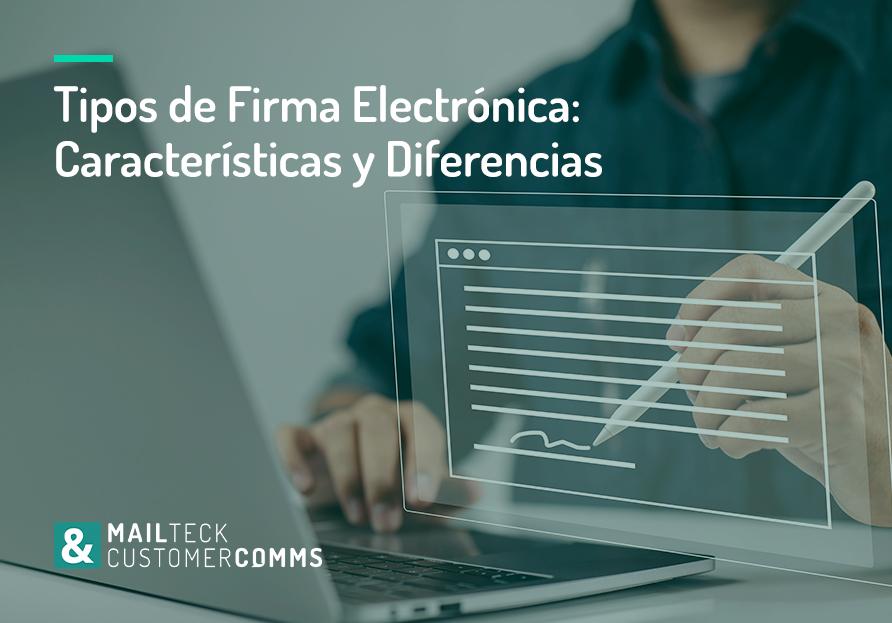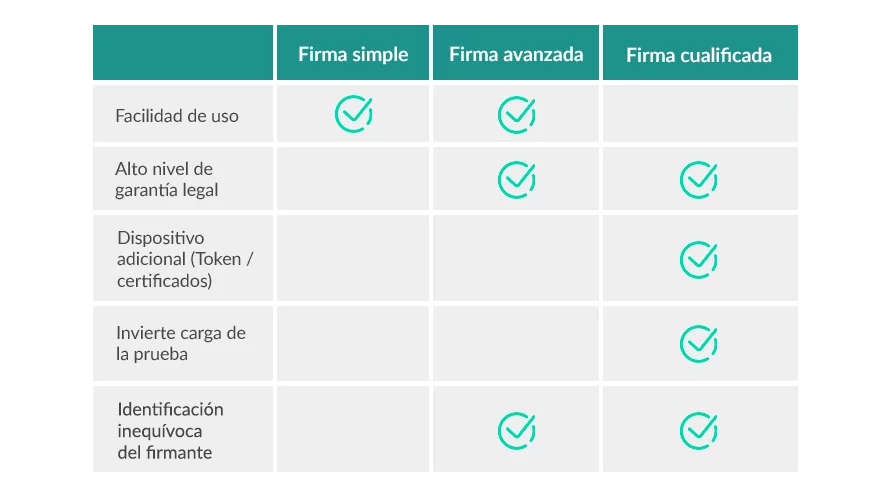
Table of Contents
- What is the electronic signature and why is it important?
- Simple electronic signature
- Advanced electronic signature
- Qualified electronic signature
- Comparison of electronic signature types
- Selection criteria according to user needs
- Legal aspects and regulatory compliance
- Electronic signature tools and service providers
1. What is the electronic signature and why is it important?
The electronic signature is a form of digital authentication suitable for signing digital documents. That is, its validity is similar to a physical signature, with the difference that it is carried out on electronic devices instead of on paper with a pen. There are several types and, although all of them are accepted and used today as a matter of course, their legal enforceability may be stronger or weaker depending on which one is used.
We explain below the types of electronic signature included and defined in the eIDAS regulation, the European standard that was created to guarantee and offer confidence in electronic interactions in the European Union between companies, citizens and public authorities. This includes areas such as e-commerce and e-procurement.
Simple electronic signature
2.1 Concept and characteristics
In fact, the simple electronic signature is not defined in the eIDAS regulation, but it refers to the most basic level of legal certainty included in the standard. It is the simplest way for a user to digitally sign and is used to associate two pieces of data or sets of electronic data. One of these sets can be considered the signature and the other, the signed. However, the simple electronic signature alone cannot identify the signatory.
2.2 Uses and applications
One of the most common uses is, for example, the acceptance of the general conditions of use with a check in a box. Also in package deliveries or employee clocking in.
2.3 Advantages and limitations
The three main advantages of the simple electronic signature are:
- Simplicity of implementation
- Price
- Ease of use
And its most important limitation is that it does not by itself identify the person signing, so it cannot be proven in case of need, such as in the case of litigation.
3. Advanced electronic signature
3.1 Definition and distinctive elements
As stated in the eIDAS, an advanced electronic signature is one that “meets the requirements set forth in Article 26”:
- That the signatory is unequivocally linked and can be unequivocally identified.
- That it has been prepared using “creation data that the signatory can use, with a high level of confidence, under his exclusive control”.
- To control that no changes are made to the signed items.
The advanced electronic signature is linked to digital identification and authentication solutions, so it has a great capacity to prove who the signer is.
3.2 Use cases and sectors
Implementing an advanced electronic signature system is recommended in cases in which complex signature processes are launched or are so relevant as to require a high level of legal reliability.
It is used in practically all sectors that have an online relationship with users and customers, such as insurance, finance, energy, telecommunications, tourism, real estate and healthcare. And to name just a few cases, advanced electronic signatures are used at times such as opening a current account, signing up for a cell phone line or a new electricity supply, or signing a new employment contract as an employee.
3.3 Benefits and restrictions
Among its main benefits are:
- Security
- High conversion rate due to ease of use
- Generating confidence in the signatory
- High legal certainty
- Integration possibilities
- Agility in finalizing contracting processes
- Guarantee of the inviolability of signed documents and the gathering of evidence
Compared to the other two levels of electronic signature, the advanced one is more complex to implement than the simple one, and at a higher cost. It is therefore not suitable for cases in which a simple electronic signature is legally sufficient. On the contrary, it offers a lower level of proof than the qualified electronic signature, which offers a presumption of legal validity.
4. Qualified electronic signature
4.1 Explanation and key aspects
The eIDAS regulation states: “A qualified electronic signature shall have a legal effect equivalent to that of a handwritten signature”. The standard also states that if it is based on a qualified certificate from an EU state it will be recognized as a qualified electronic signature in all member states. Of the electronic signatures, it is the one that offers the greatest legal guarantee, at a level equivalent to that of a handwritten signature. To use it, the signatory will need an official digital certificate or an electronic ID, with its corresponding reader. And the solution that processes it must incorporate systems that manage the characteristics of this type of signature.
4.2 Situations in which the following is required
The qualified electronic signature is mainly used in the relations of citizens and companies with public administrations such as, for example, the Tax Agency, the purchase of Treasury Bills, the online payment of taxes, the completion of public procedures requiring a high level of security, etc. However, it is also used in the private sector in cases where extreme legal certainty is sought.
4.3 Pros and cons
The main advantage of the qualified electronic signature is its presumption of legal validity. Precisely because of its high legal reliability, it also generates great confidence in the parties. In addition, in certain transactions with public administrations, it is mandatory.
Among its main disadvantages is its complexity, which is greater both at the time of implementation and execution: the signatory must have an electronic certificate or a DNIe (and in this case, the necessary hardware to read it) to carry out the rubric.
5. Comparison between the types of electronic signature
Simple vs. advanced vs. qualified electronic signature
The following table compares, in a simple and graphic way, simple, advanced and qualified electronic signatures.

6. Selection criteria according to user needs
From the signatory’s point of view, when choosing the type of electronic signature to use in a process, it is necessary to think about aspects such as:
- Legal guarantee: what legal level must be associated with the event, document or process being signed?
- Trust: for a user it is not the same to electronically sign a home purchase contract or onboarding an investment fund manager, for example, as it is to accept the terms of use of a software or mobile application. Trust is much more necessary and expected in the first two cases.
- User experience: in those cases where, due to legal compliance, several types of electronic signature can be used, the ideal is to opt for the one that offers the most attractive, fluid and fast user experience.
- Ease of use: the greater the legal authenticity of the signature, or its ability to identify the signer, the more complex the signing process is for the user. Accepting promotional mailings can be as easy as one click. To open a checking account it may be necessary to go through a digital identification process with verification and authentication. And to sign with a qualified electronic signature, the person or entity will have to request and install a valid digital certificate or an electronic ID, which is not instantaneous.
7. Legal Aspects and Regulatory Compliance
In European Union countries, the standard that regulates the characteristics and uses of electronic signatures is Regulation (EU) 910/2014, also known as eIDAS (electronic IDentification, Authentication and trust Service). The standard includes details on electronic seals and time stamps and other concepts related to electronic delivery or certification of web content or e-mails, among others.
The eIDAS has been transposed in Spain in Law 6/2020, which regulates certain electronic services. Also involved in the validity of electronic signatures are the Civil Procedure Law, regarding the probative force of private documents and the admission of evidence, and the LSSI (Information Society Services Law). Its text establishes aspects such as: “contracts entered into electronically shall produce all the effects provided for by the legal system, when consent and the other requirements necessary for their validity are met”. It also indicates that these agreements will only be valid if both parties freely decide to use electronic means for their signature.
Many countries around the world recognize electronic signatures as valid evidence in court and have laws that regulate them, with similarities but also differences. This makes it advisable to choose specialized providers whose electronic signature solutions guarantee legal compliance in the markets in which they operate.
8. Electronic signature tools and service providers
8.1 Factors to consider when choosing a supplier
When choosing an e-signature solution provider, there are several aspects that can help.
Safety is one of the most important. At MailComms, for example, we have self-developed technology designed under the security-by-design philosophy, as well as ISO certifications related to information security and privacy (27001 and 27701). In addition, the Ministry of Economic Affairs and Digital Transformation has recognized us as a qualified provider of trusted electronic services in its certified electronic notification modality.
It is also important to opt for a specialized provider, like us, in the processes of personalized, omnichannel and multi-device legal communications, which guarantees an attractive and homogeneous user experience that respects the style and corporate identity of each company.
In addition, the vendor’s ability to offer its e-signature solutions integrated into different applications that in turn connect with the customer’s systems is essential. Without forgetting the ability to customize processes according to the needs of each company, it is essential to highlight the omnichannel management capabilities, which allow the channel to be adapted according to the customer’s data.
The experience of the provider and its technology partners, such as OneSpan or Quadient in our case, will make the difference in implementing a reliable, efficient and successful electronic signature process.
8.2 Examples of solutions on the market
In the MailComms group we have several possibilities for any company to relate through simple, advanced or qualified electronic signature with its customers and users. We integrate electronic signatures, of any of the three types, in legal communications processes through our platforms CertySign and Communicalia.
In addition to offering a multi-channel and multi-device tool, we have an innovative application, Virtual Signature Room, for complex signature processes in hybrid human-digital environments.